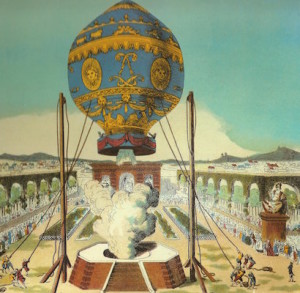They fly through the air with the greatest of ease,
Those daring young men in their flying machines.
Those daring young men in their flying machines.
My apologies for the parody. It does though capture the spirit of the Wonderful Machine Age. A time of daring do, a time when men and women pushed the boundaries of their world further and further. A time of rapid technological development.
We have always been envious of the birds. We’ve always wanted to be able to fly like them. Well, we still don’t fly like the birds do. We do, however, fly. And we do so with the greatest of ease in our marvelous flying machines.
Such was not always the case. The world’s first airline, the DELAG, was started a mere 106 years ago. The first powered, controlled, and sustained lighter than air flight took place in 1852. In 1874, Félix du Temple made the first successful heavier than air powered flight, although du Temple’s Monoplane was not completely self-powered. That feat would come in 1903 with the Wright brothers’ flight.
Myth aside, the history of flight began many centuries ago by attempting to imitate birds or riding aloft on kites. Flight via kite was generally more successful than was jumping from a tower in a bird suit and vigorously flapping manmade wings. Para-sailing is a popular sport today and can trace its roots back to those 6th century Chinese kite flyers, the first recorded one being the prisoner Yuan Huangtou.
However, if all we had available to us were flapping wings and kites, travel as we know it today would be much different. Certainly international travel would be. So lets fast forward to the 18th century in Europe, where in the latter half of 1783 a lot of hot air was occurring in France.
A momentous year was 1783. The Montgolfier brothers successfully demonstrated the feasibility of manned flight in a hot air balloon and Jacques Charles and the Robert brothers did the same in a hydrogen-filled balloon.
Suddenly ballooning became the rage and continues to this day as a sport, both hot air ballooning as well as the helium heads. In the early 20th century, ballooning was an especially popular sport in Britain. There balloons used coal gas for lift because it was readily available from the local gas works.
Of course, no sooner were hot air and hydrogen balloons flying about than people started to explore the possibility of dirigibles, or steerable balloons — what we today call airships. We will look at airships next week.
From 1783 onwards, balloons gave us our first true taste of flight, became useful in war to observe enemy troop movements and to defend against attack by enemy planes, and were of importance to the scientific community. High altitude scientific flights have given way to high altitude sporting flights and is a popular sport today. One such balloon in 2002 reached an altitude of 53 km/32.9 miles. And who hasn’t heard of the weather balloon, perhaps the most ubiquitous of scientific balloons, made über-famous as the reason for all of those UFO sightings. Can we spell R-O-S-W-E-L-L?
I have yet to take a flight on a balloon hot air or helium. It is on my list of things to do before I die. If I’m lucky there’ll be a storm and the balloon will be blown to Mysterious Island and I’ll meet Captain Nemo. One can only hope.
To some degree, balloons are the ugly step-sister in lighter-than-air flight. We retro-futurist writers love airships and seem to never give balloons a thought. Yet if it wasn’t for the balloon, we’d probably never had had the airship. After all, Count Zeppelin’s first flying experience was in an American Civil War observation balloon.
If you’ve gone ballooning, do consider telling us about your experience!

No comments:
Post a Comment